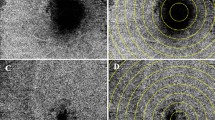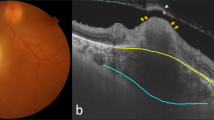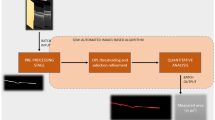Abstract
Aim
To analyse the alterations in retino-choroidal angioarchitecture in eyes with active tubercular serpiginous-like choroiditis (TB-SLC) using swept-source optical coherence tomography angiography (SS-OCTA).
Methods
This prospective cross-sectional study enrolled 34 eyes diagnosed with TB-SLC and 34 age-matched healthy controls. Data acquisition with SS-OCTA using the PLEX Elite 9000 (Carl Zeiss Meditec Inc., Dublin, CA, USA) with a 6 × 6 mm pattern centered on the foveal center was done. Automated retinal vessel length density (VLD) and perfusion density (PD) and foveal avascular zone architecture were obtained from the ARI hub. Choroidal vascularity index (CVI) and choriocapillaris flow deficits (CCFD) were obtained using Image J.
Results
Eyes with TB-SLC showed significantly reduced vessel indices in all retinal layers (P < 0.05), decreased CVI (P = 0.001) and increased CCFD (P = 0.001) as compared to healthy eyes. CCFD was increased significantly in the involved quadrants in eyes with TB-SLC when compared with the uninvolved quadrants and corresponding healthy quadrants in control subjects. CCFD showed a significant negative correlation with visual acuity (r = − 0.46, P = 0.006).
Conclusion
Eyes with TB-SLC manifest reduced VLD and PD, decreased CVI and increased CCFD. The CCFD alterations are non-uniform in these eyes, mainly located under the regions with disease activity.





Similar content being viewed by others
References
Gupta V, Gupta A, Arora S, Bambery P, Dogra MR, Agarwal A (2003) Presumed tubercular serpiginouslike choroiditis: clinical presentations and management. Ophthalmology 110(9):1744–1749. https://doi.org/10.1016/S0161-6420(03)00619-5
Bansal R, Gupta A, Gupta V, Dogra MR, Bambery P, Arora SK (2008) Role of anti-tubercular therapy in uveitis with latent/manifest tuberculosis. Am J Ophthalmol 146(5):772-779.e2. https://doi.org/10.1016/j.ajo.2008.06.011
Mackensen F, Becker MD, Wiehler U, Max R, Dalpke A, Zimmermann S (2008) QuantiFERON TB-Gold-a new test strengthening long-suspected tuberculous involvement in serpiginous-like choroiditis. Am J Ophthalmol 146(5):761–766. https://doi.org/10.1016/j.ajo.2008.06.012
Gupta A, Bansal R, Gupta V, Sharma A, Bambery P (2010) Ocular signs predictive of tubercular uveitis. Am J Ophthalmol 149(4):562–570. https://doi.org/10.1016/j.ajo.2009.11.020
Nayak S, Basu S, Singh MK (2011) Presumed tubercular retinal vasculitis with serpiginous-like choroiditis in the other eye. Ocul Immunol Inflamm 19(5):361–362. https://doi.org/10.3109/09273948.2011.590917
Gupta V, Bansal R, Gupta A (2011) Continuous progression of tubercular serpiginous-like choroiditis after initiating antituberculosis treatment. Am J Ophthalmol 152(5):857-863.e2. https://doi.org/10.1016/j.ajo.2011.05.004
Znaor L, Medic A, Karaman K, Perkovic D (2011) Serpiginous-like choroiditis as sign of intraocular tuberculosis. Med Sci Monit 17(7):CS88–CS90
Dutta Majumder P, Biswas J, Gupta A (2019) Enigma of serpiginous choroiditis. Indian J Ophthalmol 67(3):325–333
Jain S, Agarwal A, Aggarwal K, Gupta V (2017) Tubercular retinitis and retinal vasculitis. Springer, Cham, pp 81–88
Bansal R, Gupta A, Gupta V, Dogra MR, Sharma A, Bambery P (2012) Tubercular serpiginous-like choroiditis presenting as multifocal serpiginoid choroiditis. Ophthalmology 119(11):2334–2342
Wolfensberger TJ, Piguet B, Herbort CP (1999) Indocyanine green angiographic features in tuberculous chorioretinitis. Am J Ophthalmol 127(3):350–353. https://doi.org/10.1016/S0002-9394(98)00325-0
Agrawal R, Jain M, Khan R et al (2019) Choroidal structural changes in sympathetic ophthalmia on swept-source optical coherence tomography. Ocul Immunol Inflamm 00(00):1–6
Moharana B, Bansal R, Singh R, Sharma A, Gupta V, Gupta A (2019) Enhanced depth imaging by high-resolution spectral domain optical coherence tomography in tubercular multifocal serpiginoid choroiditis. Ocul Immunol Inflamm 27(5):781–787. https://doi.org/10.1080/09273948.2018.1465101
Bansal R, Kulkarni P, Gupta A, Gupta V, Dogra MR (2011) High-resolution spectral domain optical coherence tomography and fundus autofluorescence correlation in tubercular serpiginouslike choroiditis. J Ophthalmic Inflamm Infect 1(4):157–163
Pichi F, Sarraf D, Morara M, Mazumdar S, Neri P, Gupta V (2017) Pearls and pitfalls of optical coherence tomography angiography in the multimodal evaluation of uveitis 7(1):1–12
Spaide RF, Fujimoto JG, Waheed NK (2015) Optical coherence tomography angiography. Retina 35(11):2161–2162
Spaide RF, Fujimoto JG, Waheed NK (2015) Image artifacts in optical coherence tomography angiography. Retina 35(11)
Agrawal R, Salman M, Tan KA et al (2016) Choroidal vascularity index (CVI)—a novel optical coherence tomography parameter for monitoring patients with panuveitis? PLoS ONE 11(1):1–14
Chee SP, Chan SWN, Jap A (2017) Comparison of enhanced depth imaging and swept source optical coherence tomography in assessment of choroidal thickness in Vogt–Koyanagi–Harada Disease. Ocul Immunol Inflamm 25(4):528–532
Pakzad-Vaezi K, Khaksari K, Chu Z, Van Gelder RN, Wang RK, Pepple KL (2018) Swept-Source OCT angiography of serpiginous choroiditis. Ophthalmol Retin 2(7):712–719
Dingerkus VLS, Munk MR, Brinkmann MP et al (2019) Optical coherence tomography angiography (OCTA) as a new diagnostic tool in uveitis. J Ophthalmic Inflamm Infect 9(1):1–28. https://doi.org/10.1186/s12348-019-0176-9
Agarwal A, Aggarwal K, Mandadi SKR et al (2021) Longitudinal follow-up of tubercular serpiginous-like choroiditis using optical coherence tomography angiography. Retina 41(4):793–803
Nagpal M, Mehrotra N, Juneja R, Vishnoi A, Jain A (2018) Correlation of “panoramic” optical coherence tomography angiography with indocyanine green angiography characteristics of serpiginous-like choroiditis. Ophthalmic Surg Lasers Imaging Retin 49(11):859–869
Mandadi SKR, Agarwal A, Aggarwal K et al (2017) Novel findings on optical coherence tomography angiography in patients with tubercular serpiginous-like choroiditis. Retina 37(9):1647–1659
A R I Network Discover (2021) Collaborate. Understand. https://arinetworkhub.com/. Accessed 28 May 2021
Agrawal R, Gupta P, Tan KA, Cheung CMG, Wong TY, Cheng CY (2016) Choroidal vascularity index as a measure of vascular status of the choroid: measurements in healthy eyes from a population-based study. Sci Rep 6(2):1–9
Alagorie AR, Verma A, Nassisi M et al (2020) Quantitative assessment of choriocapillaris flow deficits surrounding choroidal neovascular membranes. Retina 40(11):2106–2112
Tummala GC, Chu Z, Weinstein JE, Wang RK, Pepple KL (2021) Swept source OCTA reveals a link between choriocapillaris blood flow and vision loss in a case of tubercular serpiginous-like choroiditis. Am J Ophthalmol Case Reports 21:101018
Chu Z, Weinstein JE, Wang RK, Pepple KL (2020) Quantitative analysis of the choriocapillaris in uveitis using en face swept-source optical coherence tomography angiography. Am J Ophthalmol 218:17–27
Aggarwal K, Agarwal A, Sharma A, Sharma K, Gupta V (2019) Detection of type 1 choroidal neovascular membranes using optical coherence tomography angiography in tubercular posterior uveitis. Retina 39(8):1595–1606
Brar M, Sharma M, Grewal S, Grewal D (2020) Comparison of wide-field swept source optical coherence tomography angiography and fundus autofluorescence in tubercular serpiginous-like choroiditis. Indian J Ophthalmol 68(1):106–111
Forooghian F, Yeh S, Faia LJ, Nussenblatt RB (2009) Uveitic foveal atrophy clinical features and associations. Arch Ophthalmol 127(2):179–186. https://doi.org/10.1001/archophthalmol.2008.564
Yoshida H, Terashima H, Ueda E et al (2020) Relationship between morphological changes in the foveal avascular zone of the epiretinal membrane and postoperative visual function. BMJ Open Ophthalmol 5:636
Di G, Weihong Y, Xiao Z et al (2016) A morphological study of the foveal avascular zone in patients with diabetes mellitus using optical coherence tomography angiography. Graefe’s Arch Clin Exp Ophthalmol 254(5):873–879
Ciloglu E, Unal F, Sukgen A, Koçluk Y (2019) Evaluation of foveal avascular zone and capillary plexuses in diabetic patients by optical coherence tomography angiography. Korean J Ophthalmol 33(4):359–365
Mansour AM, Schachat A, Bodiford G, Haymond R (1993) Foveal avascular zone in diabetes mellitus. Retina 13(2):125–128
Waizel M, Todorova MG, Terrada C, LeHoang P, Massamba N, Bodaghi B (2018) Superficial and deep retinal foveal avascular zone OCTA findings of non-infectious anterior and posterior uveitis. Graefe’s Arch Clin Exp Ophthalmol 256(10):1977–1984
Singh HS (1990) In vivo Choroidal circulation and its watershed zones. Eye 4(2):273–289
Wu J Sen, Lewis H, Fine SL, Grover DA, Green RW (1989) Clinicopathologic findings in a patient with serpiginous choroiditis and treated choroidal neovascularization. Retina 9(4):292–301
De Bats F, Wolff B, Mathis T et al (2015) Fundus autofluorescence imaging in White Dot Syndromes. Acta Ophthalmol 93(1)
van Velthoven MEJ, Ongkosuwito JV, Verbraak FD, Schlingemann RO, de Smet MD (2006) Combined en-face optical coherence tomography and confocal ophthalmoscopy findings in active multifocal and serpiginous chorioretinitis. Am J Ophthalmol 141(5):972–975
De Luigi G, Mantovani A, Papadia M, Carl HP (2012) Tuberculosis-related choriocapillaritis (multifocal-serpiginous choroiditis): Follow-up and precise monitoring of therapy by indocyanine green angiography. Int Ophthalmol 32(1):55–60
Knecht PB, Papadia M, Herbort CP (2013) Secondary choriocapillaritis in infectious chorioretinitis. Acta Ophthalmol 91(7):e550-555
Invernizzi A, Agarwal A, Cozzi M, Viola F, Nguyen QD, Staurenghi G (2016) Enhanced depth imaging optical coherence tomography features in areas of choriocapillaris hypoperfusion. Retina 36(10):2013–2021
Agarwal A, Agrawal R, Khandelwal N et al (2018) Choroidal structural changes in tubercular multifocal serpiginoid choroiditis. Ocul Immunol Inflamm 26(6):838–844
Agarwal A, Aggarwal K, Deokar A et al (2016) Optical coherence tomography angiography features of paradoxical worsening in tubercular multifocal serpiginoid choroiditis. Ocul Immunol Inflamm 24(6):621–630
Funding
The authors declare that no funds, grants, or other support were received during the preparation of this manuscript.
Author information
Authors and Affiliations
Corresponding author
Ethics declarations
Conflict of interest
Authors have no financial or non finacial disclosure.
Additional information
Publisher's Note
Springer Nature remains neutral with regard to jurisdictional claims in published maps and institutional affiliations.
Rights and permissions
About this article
Cite this article
Magesan, K., Sachidanandam, R., Verma, A. et al. Retino-choroidal evaluation of the macular region in eyes with tubercular serpiginous-like choroiditis using swept-source optical coherence tomography angiography. Int Ophthalmol 42, 2651–2664 (2022). https://doi.org/10.1007/s10792-022-02254-0
Received:
Accepted:
Published:
Issue Date:
DOI: https://doi.org/10.1007/s10792-022-02254-0




